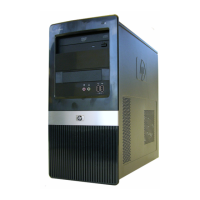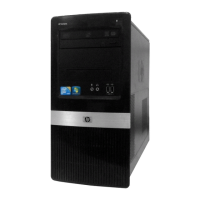dx2400 Illustrated Parts & Service Map 484985-001 page 3
Setup Utility
Basic system information is maintained in the Setup Utility held in the system ROM, accessed
by pressing the F10 key when prompted (on screen) during the boot sequence.
Password Security
Establishing a Setup password using computer setup
1. Turn on or restart the computer. If you are in Windows, click Start > Shut Down > Restart.
2. As soon as the computer is turned on, press F10 when the monitor light turns green to enter
Computer Setup. Press Enter to bypass the title screen, if necessary. If you do not press F10
when prompted, a restart will be necessary.
3. Select Security > Setup Password and follow the instructions on the screen.
4. Before exiting, click File > Save Changes and Exit.
Changing a Power-on or Setup password
1. Turn on or restart the computer. If you are in Windows, click Start > Shut Down > Restart.
2. If you want to change the Setup password, as soon as the computer is turned on, press F10
when the monitor light turns green to enter Computer Setup. Press Enter to bypass the title
screen, if necessary.
3. If you want to change the Power-On password, when the key icon appears, type your current
password, a slash (/) or alternate delimiter character, your new password, another slash (/) or
alternate delimiter character, and your new password again as shown:
current password/new password/new password.
NOTE: Type the new password carefully since the characters do not appear on the screen.
4. Press Enter.
The new password will take effect the next time the computer is restarted.
Deleting a Power-on or Setup password
1. Turn on or restart the computer. If you are in Windows, click Start > Shut Down > Restart.
2. To delete the Setup password, as soon as the computer is turned on, press F10 when the
monitor light turns green to enter Computer Setup. Press Enter to bypass the title screen.
3. To delete the Power-on password, when the key icon appears, type the current password
followed by a slash (/) or alternate delimiter character as shown: currentpassword/
4. Press Enter.
Clearing Password using the Jumper
1. Turn off the PC and unplug the the power cord.
2. Move the jumper cap on jumper CLPWD to pins 1-3.
3. Plug in the power cord and turn on the PC.
4. Hold down the F10 key during the boot process and enter BIOS setup to enter any custom
BIOS settings.
5. After changing or clearing the BIOS passwords, turn off the PC, and then replace the jumper
onto pins 3-5.
HP Insight Diagnostics
The HP Insight Diagnostics utility allows you to view information about the hardware configu-
ration of the computer and perform hardware diagnostic tests on the subsystems of the com-
puter. The utility simplifies the process of effectively identifying, diagnosing, and isolating
hardware issues.
The Survey tab is displayed when you invoke HP Insight Diagnostics. This tab shows the cur-
rent configuration of the computer. From the Survey tab, there is access to several categories of
information about the computer. Other tabs provide additional information, including diagnostic
test options and test results. The information in each screen of the utility can be saved as an html
file and stored on a diskette or USB HP Drive Key.
Use HP Insight Diagnostics to determine if all the devices installed on the computer are recog-
nized by the system and functioning properly. Running tests is optional but recommended after
installing or connecting a new device. You should run tests, save the test results, and print them
so that you have printed reports available before placing a call to the Customer Support Center.
You can find Insight Diagnostics on the Documentation and Diagnostics CD that shipped with
the computer. You can also download the tool from the HP Web site as follows:
1. Go to www.hp.com
2. Click the Software & Download driver link.
3. Enter the product number (for example, dx2400) in the text box and press the Enter key.
4. Select the specific product.
5. Select the OS.
6. Click the Diagnostics link.
7. Select HP Insight Diagnostics Offline Edition.
8. Select the proper language and click Download.
NOTE: The download includes instructions on how to create a bootable CD.
Clearing CMOS
1. Turn off the computer and any external devices, and disconnect the power cord from the
power outlet.
2. Remove the access panel.
3. On the system board, move the jumper cap from pins 2-4 (Normal) to pins 4-6 (Clear CMOS)
Keep the cap on pins 4-6 for about 5~10 seconds, and then move the cap back to pins 2-4.
4. Replace the access panel, external devices, reconnect the power cord, and then turn on the
computer.
5. Hold down the Del key during the boot process to enter BIOS setup and re-enter data.
CAUTION: Other than when clearing CMOS, never remove the cap from the default position.
Removing the cap will cause system boot failure.
Computer Setup Menu
Heading Option / Description
Main System Time Allows you to set system time.
System Date Allows you to set system date.
Language Allows you to select the language.
Floppy Dis-
kette A
Allows you to set to Disabled, 1.44 MB 3.5”, Not Installed.
1st Drive
2nd drive
3rd Drive
4th Drive
Allow you to: view capacity, transfer mode, SATA speed,
NCQ. Also allows you to run HDD self-test for selected chan-
nel: SMART status check, SMART short self test, SMART
extended self test.
System Infor-
mation
Allows you to view installed memory, memory banks 1-4,
BIOS revision, core version, model number, product number,
asset tag (press Enter to change).
Advanced CPU Type View only.
CPU Speed View only.
Cache RAM View only.
Primary Video
Adapter
Allows you to select boot display device when more than 2
video options are offered by system: Integrated (Onboard),
PCI, PCI-Ex16, PCI-Ex1.
Onboard
Video Mem-
ory Size
1 MB, 8 MB.
DVMT Mode
Select
Allows you to set video memory mode to: Fixed mode,
DVMT mode.
DVMT/Fixed
Memory
Allows you to set video memory size to: 128 MB, 256 MB,
Maximum DVMT (available for DVMT Mode only).
PS/2 Mouse Disable/enable/auto detect
USB Legacy
Mode Support
Disable/enable (USB keyboard, mouse, and flash media).
Onboard LAN Disable/enable onboard LAN controller.
Onboard LAN
Boot ROM
Disable/enable the boot ROM of the onboard LAN chip.
SATA1 Con-
troller
Disable/enable the SATA1 controller
SATA1 Con-
troller Mode
If SATA1 controller enabled, allows you to set the mode to
IDE or AHCI.
SATA2 Con-
troller
Disable/enable the SATA2 controller.
Onboard
Audio
Auto/disable/enable.
Internal
Speaker
Disable/enable.
Supervisor
Password
Allows you to change the supervisor password.
User Pass-
word
Allows you to change the user password.
Power After AC
Power Failure
Allows you to select system restart behavior after power loss:
Stay off, Power on, Auto.
XD Disable/enable XD bit.
Boot Boot-time
Diagnostic
Screen
Disable/enable
1st Boot
Device, 2nd
Boot Device,
3rd Boot
Device, 4th
Boot Device
Allows you to specify which device groups will boot first,
second, third, and fourth or to disable any
of the four: Floppy group, CD-ROM group, Hard drive group,
Network boot group. MS-DOS drive lettering assignments
maybe apply after a non-MS-DOS operating system has
started.
Floppy Group
Boot Priority
Specifies boot device priority within removable devices.
CD-ROM
Boot Priority
Specifies boot device priority within CD/DVD drives.
Hard Drive
Boot Priority
Specifies boot device priority within hard drives.
Network
Group Boot
Priority
Specifies boot device priority within bootable network
devices.
Exit Exit Saving
Changes
Press Enter to exit saving changes.
Exit Discard-
ing Changes
Press Enter to exit discarding changes.
Load Setup
Defaults
Press Enter to load setup defaults.
Discard
Changes
Press Enter to discard changes.
Save Changes Press Enter to save changes.
POST Audible Codes
Beeps Meaning Recommended Action
1 short, 1
long
Bad memory or memory con-
figuration error
Check that the memory modules have been
installed correctly and that proper modules are
used.
2 short, 1
long
No graphics card installed or
graphics card initialization
failed.
For systems with a graphics card:
1. Reseat the graphics card. Power on the sys-
tem.
2. Replace the graphics card.
3. Replace the system board.
For systems with integrated graphics, replace
the system board.
3 short, 1
long
CPU configuration error or
invalid CPU detected before
graphics card initialized.
1. Upgrade the BIOS to proper version.
2. Change the processor.
POST Audible Codes (continued)
Beeps Meaning Recommended Action
1 short No legacy floppy drive or opti-
cal drive found.
1. Check cable connections.
2. Run the Computer Setup utility and ensure
the device port is enabled.
2 short No floppy diskette or CD
found.
1. Check the type of drive that you are using
and use the correct media type.
2. Replace the diskette or CD with a new one.
3 short Flashing not ready (missing
utility or BIOS image file, etc.)
Upgrade the BIOS to proper version.
4 short Flashing operation has failed
(checksum error, corrupted
image, etc.)
1. Verify the correct ROM.
2. Flash the ROM if needed.
3. If an expansion board was recently added,
remove it to see if the problem remains.
4. Clear CMOS.
5. If the message disappears, there may be a
problem with the expansion card. 6. Replace
the system board.
5 short BIOS recovery was successful No action required.

